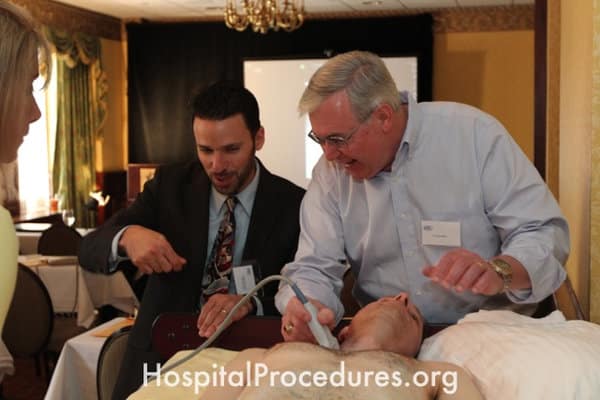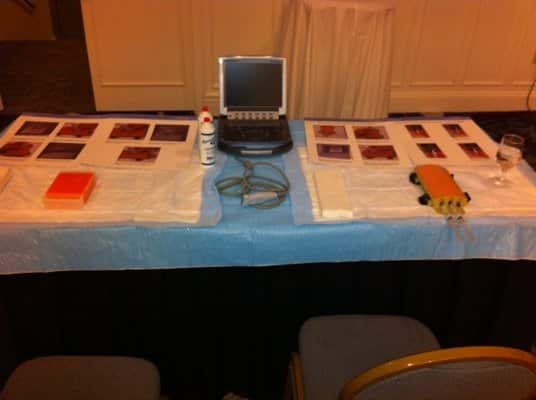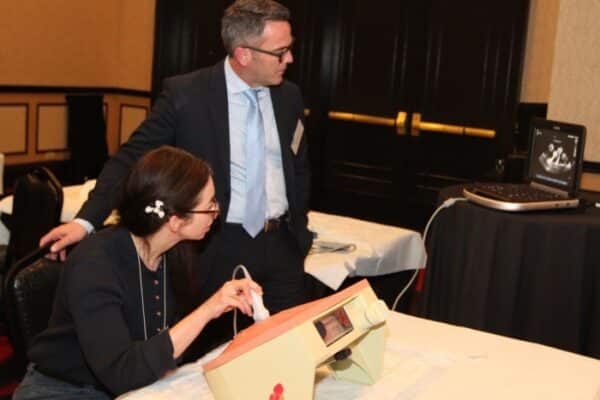Ultrasound guided central line placement is a safer alternative to a landmark based technique.

What you will Learn in the Vascular Ultrasound Course
The vascular ultrasound course teaches the clinician how to successfully place internal jugular and subclavian central venous catheters under ultrasound guidance. Preparation of the ultrasound machine and probe and techniques using in plane and out of plane approaches will be taught.
The HPC Hospitalist and Emergency Procedures course will teach you how to perform central line placement in addition to endotracheal intubation, stylet-guided intubations, laryngeal mask airway (LMA) placement, King tube placement, or fiberoptic intubations. ultrasound-guided peripheral IV access, arterial lines, POCUS exams (RUSH exams and E-FAST exams), thoracentesis, paracentesis, lumbar punctures, chest tube placement, pigtail catheter placement, needle thoracostomy, procedural sedation, and ventilator management.
Why you should choose us for your vascular ultrasound course
Our vascular ultrasound training is a component of the live Hospitalist and Emergency Procedures CME course.
Take your skills to the next level with our comprehensive Vascular Ultrasound Course!
Vascular Ultrasound Photos
More information about Vascular Ultrasound
Ultrasound is a medical technique which has greatly enhanced procedural safety. The procedure requires hands-on simulation based training to learn but then ultrasound guided central lines may be performed safely and easily by an doctor or midlevel healthcare provider.
- Vascular ultrasound provides the physician with imaging of the patient’s veins and arteries. The physician may interpret the images and information collected during a vascular ultrasound to help diagnose or rule out potential issues in the vascular system and recommend treatment accordingly.
- Cardiac ultrasound provides the physician with important information about cardiac activity. The physician may interpret the images and information collected during a cardiac ultrasound to diagnosed pericardial tamponade, left ventricular dysfunction and right ventricular strain. These studies provide important information when determining the cause of hypotension when a patient is in shock.
- Breast ultrasound provides the physician with internal imaging of the patients breast tissue. One of the most common reason to perform a breast ultrasound is to analyze lumps or cysts. Breast ultrasound is a highly valuable procedure for early detection of serious breast related issues.
- Abdominal ultrasound provides the physician with imaging of several of the patients internal organs. The physician may elect to perform an abdominal ultrasound to aid in their analysis of a variety of abdominal issues including irregular function, pain, or enlargement.
- There are three variations of the Pelvic ultrasound – rectal, vaginal, and abdominal. Like other ultrasound procedures these are used to collect valuable diagnostic insight.
- An Obstetrical ultrasound is perhaps the most well known ultrasound. An Obstetrician performs this procedure to image a fetus or embryo and to collect information during a female patient’s pregnancy.
- A physician may request a Thyroid ultrasound if they suspect a patient is experiencing abnormal thyroid activity. Based on the thyroid imaging the physican may recommend follow up tests or procedures accordingly.
- A Scrotum ultrasound provides testicular imaging in a male patient and is used to detect or analyze testicular masses, testicular pain, and other related issues.
As you can see ultrasound is a valuable tool which may be regularly utilized by a wide variety of physicians for diagnostic and analytical purposes. Vascular ultrasound in particular helps to assist in other medical procedures such as central line placement.
If you have specific questions or would like to further discuss any ultrasound guided procedure we invite you to ask an HPC physician personally by contacting us at www.Facebook.com/HospitalProcedures. We encourage discussion regarding any medical procedure you’re interested in and we look forward to hearing from you.
Vascular Ultrasound Course Trains Students in:
- Ultrasound physics, knobology and features
- Use of ultrasound to identify vascular anatomy
- Ultrasound guided cannulation of peripheral and central veins
- Maintaining sterile technique while performing ultrasound guided vascular procedures
- Use of ultrasound for central line placement
Vascular Ultrasound Blogs
How Hospitals Can Tap into the Power of Emergency Medicine PAs
Ultrasound-Guided Paracentesis
Hospitalist and Emergency Procedures CME Courses Available
Register HERE 21 days before the course to SAVE $50-150 and get the following:
- 12 month online access to Online CME course, procedure video bundle, instructional posters
- Indefinite online access to PDFs of all course lectures, course handouts, and HPC Adult Critical Care and Emergency Drug Reference Drug
2024-08b Hospitalist and Emergency Procedures Course – San Antonio, TX (Sunday ONLY)
Courtyard Marriott San Antonio Riverwalk Hotel
November 17, 2024
Live Course & Online Course
(Sunday ONLY)
Compare Registration Types
2024-08a Hospitalist and Emergency Procedures Course – San Antonio, TX (Saturday ONLY)
Courtyard Marriott San Antonio Riverwalk Hotel
November 16, 2024
Live Course & Online Course
(Saturday ONLY)
Compare Registration Types
2024-08 Hospitalist and Emergency Procedures Course – San Antonio, TX (WEEKEND)
Courtyard Marriott San Antonio Riverwalk Hotel
November 16-17, 2024
Live Course & Online Course
(Saturday & Sunday)
Compare Registration Types
2024-07b Hospitalist and Emergency Procedures Course – New Orleans, LA (Sunday ONLY)
Intercontinental New Orleans Hotel
October 20, 2024
Live Course & Online Course
(Sunday ONLY)
Compare Registration Types
2024-07a Hospitalist and Emergency Procedures Course – New Orleans, LA (Saturday ONLY)
Intercontinental New Orleans Hotel
October 19, 2024
Live Course & Online Course
(Saturday ONLY)
Compare Registration Types
2024-07 Hospitalist and Emergency Procedures Course – New Orleans, LA (WEEKEND)
Intercontinental New Orleans Hotel
October 19-20, 2024
Live Course & Online Course
(Saturday & Sunday)
Compare Registration Types
2024-06b Hospitalist and Emergency Procedures Course – Seattle, WA (Sunday ONLY)
Crowne Plaza Seattle Downtown Hotel
September 8, 2024
Live Course & Online Course
(Sunday ONLY)
Compare Registration Types
2024-06a Hospitalist and Emergency Procedures Course – Seattle, WA (Saturday ONLY)
Crowne Plaza Seattle Downtown Hotel
September 7, 2024
Live Course & Online Course
(Saturday ONLY)
Compare Registration Types
2024-06 Hospitalist and Emergency Procedures Course – Seattle, WA (WEEKEND)
Crowne Plaza Seattle Downtown Hotel
September 7-8, 2024
Live Course & Online Course
(Saturday & Sunday)
Compare Registration Types
2024-05b Hospitalist and Emergency Procedures Course – Denver, CO (Sunday ONLY)
Sheraton Denver Downtown Hotel
July 21, 2024
Live Course & Online Course
(Sunday ONLY)
Compare Registration Types









